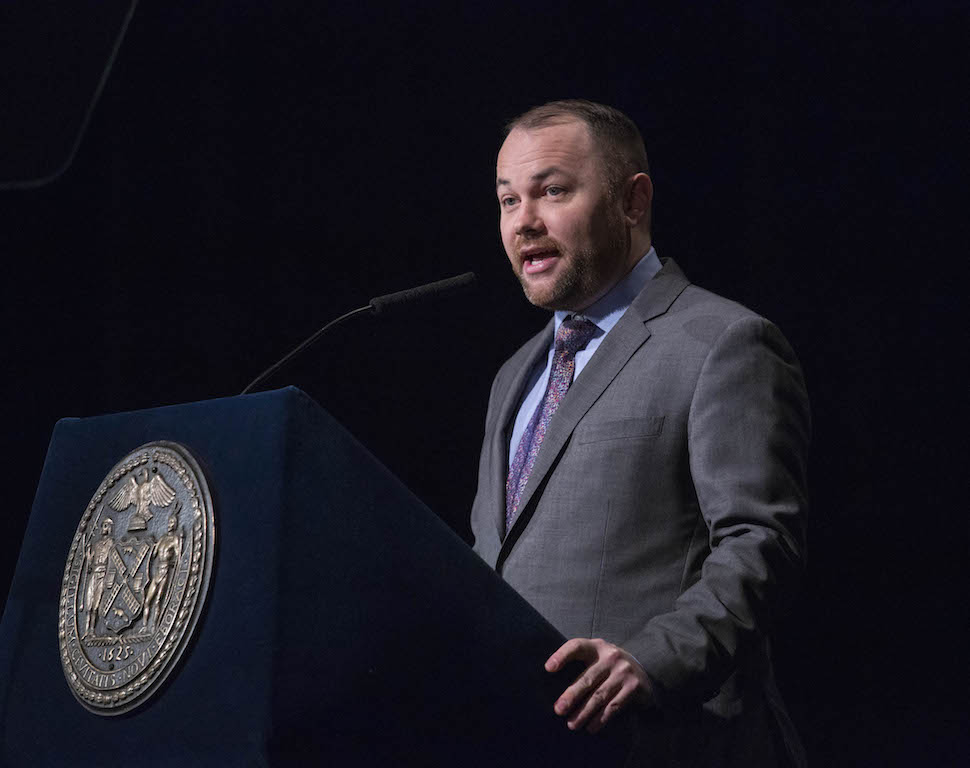
BY RICO BURNEY | City Council Speaker Corey Johnson delivered his first State of the City address on Tues., March 5. But it wasn’t just a feel-good list of blandishments about projects and people. Rather, it was a focused presentation of sweeping ideas to improve transportation in the city. In Johnson’s speech and in a 104-page report that accompanied it, he laid out a bold vision.
His primary proposal is for the Metropolitan Transportation Authority’s New York City Transportation Authority — the state authority that owns the city’s bus system and has operated the city-owned subway system since 1953 — and the M.T.A.’s Bridge and Tunnel Authority to be spun off into a new mayoral-controlled agency tentatively titled Big Apple Transit, or BAT.
Johnson argues that the current M.T.A. management structure results in the authority existing “in a vacuum of accountability,” and gives the governor and suburban counties disproportionate control over the city’s transit system. He argues that by placing the city’s transit under the mayor’s direct oversight, people would know exactly who to hold accountable.
Currently, the M.T.A. is effectively controlled by a board of 17 voting members who collectively cast a total of 14 votes.
Six members are appointed by the governor, four are recommended by the mayor to the governor, and three more members are recommended to the governor by the two Long Island counties and Westchester. The final four members are recommended to the governor by four additional suburban counties, and they cast one collective vote. All appointees are then confirmed by the state Senate.
Under Johnson’s proposed system, a new “mobility czar” would report directly to the mayor and oversee B.A.T., as well as the city’s Department of Transportation and the Taxi and Limousine Commission.
The governor’s communications director Dani Lever was quick to counter that the city already technically owns the subway but chooses not to run it because it “could never afford it.”
“[The city] can cancel the M.T.A. lease with one year’s notice,” Lever wrote on Twitter. “The Mayor has total veto over the state and city funded N.Y.C.T. capital plan. The City does not want to take N.Y.C.T. from the M.T.A. because they get billions of state dollars that they would lose. This is funding that no other city or regional transit system gets.”
Johnson’s report argues that this is not the case, and that the city could find new ways to raise money. His plan calls for bringing in new revenue from congestion pricing, which he vowed the City Council would pass by itself if Albany fails to do so. Other new possible revenue streams Johnson cited, include a “millionaires’ tax,” raising the sales tax from 8.9 to 9.25 percent and a “progressively structured transfer tax” on real estate transactions, among other things.
While his B.AT. proposal is the one that grabbed the most headlines, the rest of Johnson’s 50-minute address — backed up by those in his report — was also full of ambitious ideas that are arguably even more audacious than the speech’s marquee proposition.
He called for a major overhaul of the city’s aboveground transit network, including adding at least 30 miles of new bus lanes and 50 miles of new protected bike lanes per year. He also is proposing installing bus lane cameras for enforcement, plus Transit Signal Priority technology, to reduce the amount of time buses spend at red lights, on all routes by 2030, as well as significantly expanding the city’s pedestrian plaza program.
Johnson’s report aims for these changes to increase bike ridership from 3 percent of trips to 14 percent of trips by 2030 and to half the number of private vehicles in the city by 2050.
Danny Pearlstein of the Riders Alliance, in an interview with Gothamist, praised Johnson’s advocacy for speeding up the city’s painfully slow buses. But he also said that passing congestion pricing is the biggest issue at the moment.
“Once that’s been implemented, there will be ample time for conversations to make sure that the subway never falls apart again,” Pearlstein said.
Another of Johnson’s BAT-related proposals is to include developing a zoning plan to incentivize developers building near subway stations to construct new entrances and elevators to nearby stations through a “density bonus.” Also on his transit wish list is to end what he called a “regressive fare system” — and possibly even make the whole system free.
“Fare increases should not be the be-all and end-all for transit funding,” he stated. “Instead of raising fares, we could be thinking about freezing fares, lowering fares and maybe even a system without fares.”

















